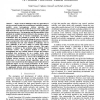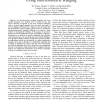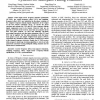ICC
2007
IEEE
14 years 6 months ago
2007
IEEE
— Novel concepts are introduced for finding the relationship between multiuser detection (MUD) and multiuser transmission (MUT), so that the study in MUT can benefit from the w...
ICC
2007
IEEE
14 years 6 months ago
2007
IEEE
— – Major research challenges in the next generation of wireless networks include the provisioning of worldwide seamless mobility across heterogeneous wireless networks, the im...
ICC
2007
IEEE
14 years 6 months ago
2007
IEEE
Abstract—A new 4 × 1 scheme of transmitting two real orthogonal space-time block codes (O-STBC) on the I- and Q-channels with pulse-shaped offset QAM is proposed. This scheme ac...
ICC
2007
IEEE
14 years 6 months ago
2007
IEEE
– It is well known that IEEE 802.11 WLAN is highly inefficient for transporting voice data. For example, if one simply takes the data rate of 802.11b, 11Mbps, and divide it by tw...
ICC
2007
IEEE
14 years 6 months ago
2007
IEEE
— Mobile users are expected to be highly dynamic in next generation mobile networks. Additionally they will be served a wide variety of services with different transmission rates...
ICC
2007
IEEE
14 years 6 months ago
2007
IEEE
— An interferometric ranging technique has been recently proposed as a possible way to localize ad hoc and sensor networks. Compared to the more common techniques such as receive...
ICC
2007
IEEE
14 years 6 months ago
2007
IEEE
Abstract— Coverage is a fundamental problem in sensor networks. In this paper, we addressed the coverage problem from two different view points and refer to them as the worst and...
ICC
2007
IEEE
14 years 6 months ago
2007
IEEE
— The proliferation of heterogeneous devices, ranging from mobile communication to home electronics and their internetworking have resulted into the development of a "person...
ICC
2007
IEEE
14 years 6 months ago
2007
IEEE
—With single-carrier frequency-domain equalization (SC-FDE), the carrier-frequency offset (CFO) and samplingfrequency offset (SFO) are embedded in the phase rotations of the comp...
ICC
2007
IEEE
14 years 6 months ago
2007
IEEE
— For cognitive radio networks, a popular approach to dynamic spectrum allocation (DSA) is game theoretic, which improves spectrum efficiency in a distributed manner. In a doubl...



